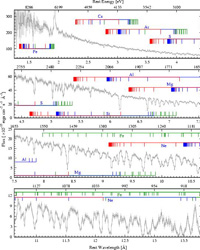|
Title Associate Professor Education Ph.D. Physics – University of Leicester (UK), 1988 Previous Experience After obtaining his Ph.D., Dr George worked as a Post-doctoral fellow in the Institute of Astronomy at the University of Cambridge (UK) for 3 years. He then spent 9 years working at NASA’s Goddard Space Flight Center (Greenbelt, MD) as a contractor for the Universities Space Research Association. During this time he worked on scientific research and the support of several major X-ray missions. Dr. George joined UMBC in 2000 as an Associate Professor, and was awarded tenure in 2007. Professional Interests With the possible exception of the very smallest, all galaxies in the observable universe (including our own) are thought to harbor a “supermassive” black hole at their center. The mass of the black hole varies from galaxy to galaxy, but those we know about currently appear to have masses in the range 106 to 1010 times that of our Sun (i.e. 1036 to 1040 kg) and hence have “event horizons” equivalent to radii about five times the radius of our Sun to more than twice Neptune’s orbit around the Sun. The enormous gravitational fields resulting from the presence of such supermassive black holes clearly have a strong influence on the inner regions of the galaxy. These regions offer the opportunity to test fundamental physics such as General Relativity in extreme conditions – way beyond anything ever possible in a terrestrial laboratory. My primary research interests are in the study of “Active Galactic Nuclei” (AGN), which represent 10-20% of the large or “regular” galaxies in the local universe (and possibly an even larger fraction in the early universe). These are galaxies in which the radiation (in photons) from the central regions often far exceeds that from all the stars in the rest of the galaxy combined. The origin of this intense energy output is thought to be the result of matter falling onto a “supermassive” black hole (with a mass 106 to 109 times that of the sun). This “accretion” process releases potential energy, much of which is ultimately converted to the intense radiation field. Spectroscopic observations of this “primary” radiation allows us to study many aspects of the numerous basic physical processes involved, along with other important factors such as the geometry of the circumnuclear material. However via various feedback processes this radiation field influences the accretion process itself, and the interaction of the radiation with the accreting material also leads to various “reprocessed” (or “secondary”) features imprinted on the observed spectrum. My work involves the observation and interpretation of UV, X-ray and g-ray spectra from local AGN, with the goal of furthering our understanding of all the physical processes underway within the innermost regions. To this end I have experience with data collected by the following satellites: EXOSAT, Ginga, IUE, ROSAT, the Hubble Space Telescope, ASCA, RXTE, BeppoSAX, the Chandra X-ray Observaory, FUSE, and XMM-Newton. Selected Publications Relativistic Iron K Emission and Absorption in the Seyfert 1.9 Galaxy MCG -5-23-16, Braito, V., Reeves, J.N., Dewangan, G.C.; George, I.M, and 8 other authors, 2007, ApJ 67, 978. Variable iron-line emission near the black hole of Markarian 766, Miller, L., Turner, T.J., Reeves, J.N., George, I.M., Porquet, D., Nandra, K., Dovciak, M., 2006, A&A 453, 13L Complex X-Ray Absorption and the Fe Kα Profile in NGC 3516. Turner, T.J., Kraemer, S.B., George, I.M., Reeves, J.N., Bottorff, M.C., 2005, ApJ 618, 155 Mass Loss from the Nuclei of Active Galaxies. Crenshaw, D.M., Kramer S.B., George, I.M., 2003, Annual Review of Astronomy & Astrophysics, 41, 117 The Ionized Gas and Nuclear Environment in NGC 3783. I. Time-averaged 900 Kilosecond Chandra Grating Spectroscopy. Kaspi, S., Brandt, W.N., George, I.M., Netzer, H., and 14 other authors, 2002, ApJ, 574, 643 X-ray Observations of Optically-Selected, Radio-Quiet Quasars I: The ASCA results,George, I.M., Turner, T.J., Yaqoob, T. Netzer, H., Laor, A., Mushotzky, R.F., Nandra, K., Takahashi, T., 2000, ApJ, 531, 52 The X-ray Spectral Variability of the Seyfert Galaxy NGC 3227. George, I.M., Mushotzky, R.F., Turner, T.J., Yaqoob, T. Ptak, A., Nandra, K., Netzer, H., 1998, ApJ, 509, 146 ASCA Observations of the Ionized Gas in the Seyfert Galaxy NGC 3783. George, I.M. Turner, T.J., Mushotzky, R.F., Nandra, K., Netzer, H., 1998, ApJ, 503, 174 ASCA Observations of Seyfert-I galaxies: III The Evidence from Absorption & Emission due to Photoionized Gas. George, I.M., Turner, T.J., Netzer, H., Nandra, K., Mushotzky, R.F., Yaqoob, T. 1998, ApJS, 114, 73 Evidence for absorption due to highly-ionized gas in the radio-quiet quasar PG 1114+445. George, I.M., Nandra, K., Laor, A., Turner, T.J., Fiore, F., Netzer, H., Mushotzky, R.F., 1997, ApJ, 491, 508 X-ray Reflection from Cold Matter in Active Galactic Nuclei and X-ray binaries.George, I.M., Fabian, A.C. 1991, MNRAS, 249, 352 |
|

